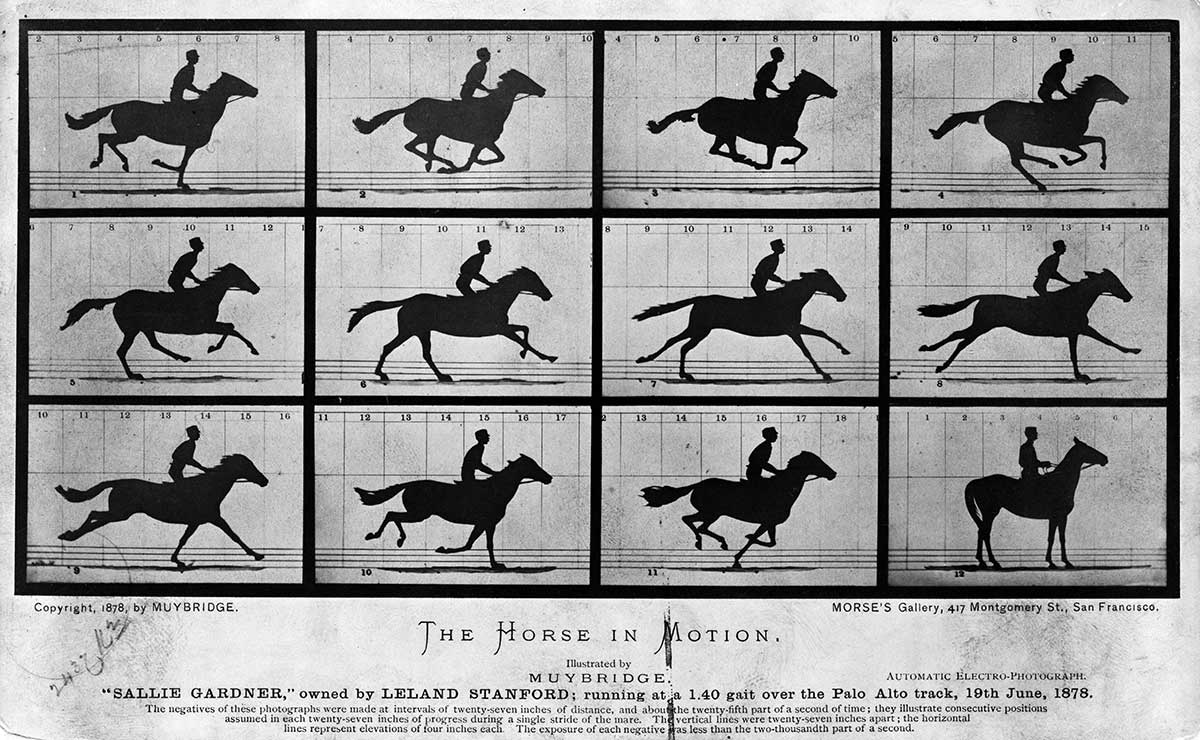
Eadweard Muybridge is one of the most historically significant figures of the 19th century, whose photographic breakthroughs paved the way for moving image technology. An accomplished photographer and bookseller from England, he is best-known as the inventor of the zoopraxiscope, a rotating device containing still images, which, when spun at a fast pace, could create the illusion of motion. This device, in turn, most likely led the way for Thomas Edison and William Kennedy Dickson’s Kinetoscope, or the first moving image machine. We celebrate Muybridge’s long-lasting legacy with a series of facts about his life and work.
1. He Has an Unusual Name

Eadweard Muybridge might be remembered for his unusual name, but it wasn’t the one he was born with. In fact, he changed his name numerous times over the course of his life. Born in 1830 in Kingston upon Thames, England as Edward James Muggeridge, he emigrated to the United States at the age of 25, where he subsequently changed his name to Eduardo Santiago. Then he played around with his surname, trying out Muggridge, Muygridge, and finally Muybridge. It wasn’t until 1870 that he settled on the name Eadweard Muybridge, taking his first name from the name of a monument in the town where he grew up. Although he settled with this name, he still sometimes signed the name Helios on his photographs.
2. Muybridge Was a Pioneering Photographer

As a young man in the US, Muybridge was a prolific photographer who documented a series of significant natural landscapes and industrial changes, including railroads and steamships, earning a widespread reputation as a world-leading photographer. He was employed by the United States Government to photograph a series of Pacific Coast Lighthouses, and later travelled to Alaska at a time when it was in the process of being acquired by Russia. He also made striking documents of the American landscape, including Yosemite Valley. Along with taking photographs, Muybridge also experimented with how cameras were put together, and he even invented one of the world’s first camera shutters in 1869.
3. He Photographed a Moving Horse

Get the latest articles delivered to your inbox
Sign up to our Free Weekly NewsletterIn one of his first forays into moving imagery, Muybridge was asked to photograph a moving horse, in order to help former California governor and railroad tycoon Leland Stanford prove that a racehorse’s all four hooves lifted off the ground during high-speed movement. Muybridge spent around five years researching how to capture a running horse without it turning into an indistinct blur. He lined up a series of 12 cameras along one side of the racetrack, and a long white backdrop on the other. Muybridge’s clever specially designed cameras used for the process could take 12 shots in less than half a second – and he was able to prove that yes, indeed, Leland Stanford was right after all, that a horse can fly, even if we cannot see it with the naked eye.
4. He Made Radical Studies of Motion

Building on the success of his racehorse photography, Muybridge is best-known for his sequential photographs of people and animals caught in a series of movements side-by-side, which we often see in publications today as a strip or reel. Working in a research center at the University of Pennsylvania, Muybridge made thousands of photographs showing people carrying out manual labor, everyday activities, or playing sports, conveying movement in a way that had never been seen in such a way before. In order to animate the movements that he had caught on camera, Muybridge invented the ingenious spinning zoopraxiscope, which could capture movement on camera for the first time in history. He thus paved the way for the monumental cinematic breakthroughs of the next generation.





